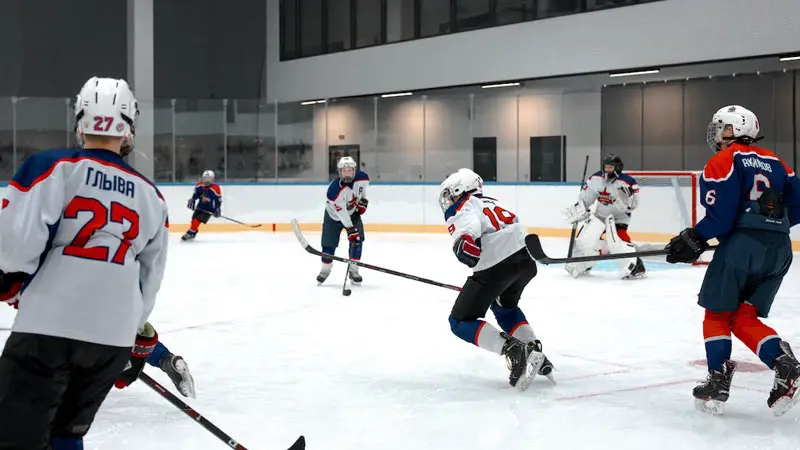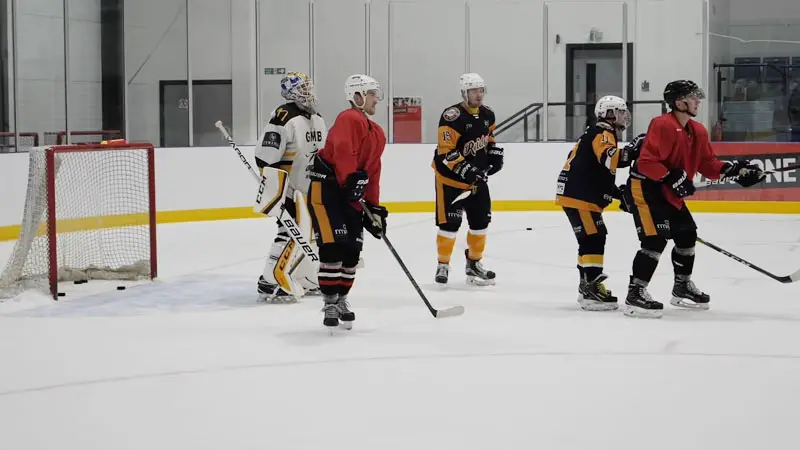In the high-speed realm of ice hockey, the strategic orchestration of line changes is an art that separates elite teams from the rest.
From assessing individual energy levels to responding to dynamic game situations, hockey players navigate a complex web of factors to determine precisely when to swap lines.
This blog post delves into how do hockey players know when to change lines exploring the cues players rely on, the role of game situations, and how coaches contribute to the decision-making process.
Understanding how hockey players navigate these decisions provides a fascinating glimpse into the tactical minds at play on the ice. So, stay sharp.
The Basics of Hockey Lines
Hockey lines, also known as forward lines, are an integral aspect of ice hockey that dictate the player’s combinations on the ice during a game.
Understanding the basics of hockey lines is crucial for players, coaches, and fans alike, as it directly influences team dynamics and gameplay. Here are some key points elaborating on the basics of hockey lines:
Roles and Positions
Hockey lines consist of three forward positions – left wing, center, and right wing. Each position has specific responsibilities.
The center typically takes faceoffs, and the left and right wings support offensive and defensive plays, respectively. Understanding these roles is fundamental to effective teamwork and strategic play.
Line Changes
Coaches strategically rotate lines throughout a game to ensure players remain fresh and maximize performance. Line changes occur during stoppages in play, allowing players to substitute on and off the ice.
Effective line changes help maintain a high level of energy and prevent fatigue among players, contributing to sustained team performance.
Chemistry and Cohesion
Successful hockey lines are built on chemistry and cohesion among players. Teams often experiment with different line combinations to find groups that complement each other’s playing styles.
A line that communicates well, anticipates each other’s moves, and understands individual strengths and weaknesses is more likely to be effective on the ice.
Specialized Lines
Coaches may create specialized lines for specific situations, such as power plays or penalty kills.
A power-play line, for instance, is designed to capitalize on the numerical advantage when the opposing team has a player in the penalty box.
These specialized lines often consist of players with particular skills suited to the situation at hand.
Adaptability and Flexibility
Hockey is a dynamic game, and adaptability is key. Coaches and players need to be flexible in adjusting lines based on the flow of the game, opponent strategies, and other factors.
Being able to adapt lines on the fly ensures that the team can respond effectively to changing circumstances and maintain a competitive edge.
Hockey lines play a pivotal role in shaping the dynamics of a game.
How Do Hockey Players Know When to Change Lines?

Effective line changes are crucial in maintaining a high level of performance and energy throughout a hockey game. Players need to be strategic in deciding when to swap lines to ensure fresh legs on the ice.
Here are some of the key considerations that guide hockey players in knowing when to change lines:
Shift Duration and Fatigue
Players are mindful of their shift duration to avoid fatigue, which can impact their performance and decision-making.
Shifts typically last around 30 to 45 seconds, and players often use their energy levels as a cue for a line change.
Recognizing signs of fatigue, such as slower skating or decision-making, prompts players to head to the bench for a substitution.
Game Situations
Players assess the current game situation to determine the opportune moment for a line change. For example, during offensive zone possession, a team might delay a line change to maintain pressure on the opposing team.
Conversely, in defensive situations or after an icing call, players may prioritize getting fresh legs on the ice to enhance defensive capabilities.
Puck Possession and Transition
Puck possession is a critical factor in deciding when to change lines. Players often look for a controlled exit from the defensive zone or a successful entry into the offensive zone before making a change.
This ensures a smooth transition without leaving the team vulnerable to a sudden change in possession or an opponent’s counterattack.
Coordinated Changes and Communication
Effective line changes require coordination among players on the ice and clear communication with teammates on the bench.
Players use non-verbal cues, such as tapping their stick on the ice or calling out to the bench, to signal their intention to change lines.
Coordinated changes prevent confusion and ensure that there are always the appropriate number of players on the ice.
Strategic Considerations by Coaches
Players often follow the strategic decisions of their coaches regarding line changes. Coaches may have predefined plans for specific situations, such as sending out specialized lines for power plays or penalty kills.
Players pay attention to the coach’s signals or instructions from the bench, aligning their line changes with the overall game strategy.
Hockey players make informed decisions about when to change lines based on factors such as shift duration, game situations, puck possession, coordinated communication, and strategic considerations from coaches.
The Importance of Line Changes

Line changes are a fundamental aspect of hockey, contributing significantly to a team’s overall performance and success on the ice.
Understanding the importance of line changes is crucial for players, coaches, and fans alike. Here are some key points highlighting the significance of line changes in hockey:
Maintaining Energy and Intensity
Line changes play a pivotal role in managing player fatigue and maintaining a high level of energy and intensity throughout the game. Hockey is a demanding sport that requires bursts of speed, agility, and physicality.
Regular shifts and timely line changes ensure that players can perform at their peak without succumbing to exhaustion, ultimately sustaining the team’s overall competitiveness.
Strategic Adaptability
Line changes provide coaches with the ability to adapt strategically to the evolving dynamics of a game.
By rotating lines based on the situation whether it be offensive pressure, defensive resilience, or specialized situations like power plays teams can optimize their player combinations to exploit opponent weaknesses and respond effectively to varying game scenarios.
Enhancing Team Chemistry
Line changes allow players to develop and strengthen their chemistry with different teammates. Coaches often experiment with line combinations to discover the most effective player pairings.
This experimentation fosters a sense of familiarity and understanding among players, contributing to better coordination, communication, and teamwork on the ice.
Maximizing Specialized Skills
Different players bring unique skills and strengths to the game. Line changes enable coaches to strategically deploy players with specialized abilities in specific situations.
For instance, a team might send out a line known for its scoring prowess during a power play or rely on a defensively sound line to protect a lead. This targeted use of skills enhances the team’s overall performance and versatility.
Preventing Defensive Vulnerabilities
Timely line changes are crucial to preventing defensive vulnerabilities that may arise due to tired players on the ice.
Fatigued players are more prone to mistakes, slower reactions, and diminished physical performance, leaving the team susceptible to counterattacks.
Regular substitutions help maintain a fresh defensive presence, reducing the likelihood of defensive lapses.
Role of the Coach in Signaling Line Changes

In the fast-paced and dynamic sport of hockey, effective communication between coaches and players is paramount.
One crucial aspect of this communication is the coach’s role in signaling line changes, a tactical maneuver that can significantly impact a team’s performance.
Here are some of the key points elaborating on the role of the coach in signaling line changes:
Strategic Decision-Making
Coaches are responsible for making strategic decisions about when to change lines based on the flow of the game, the score, and specific game situations.
By observing the on-ice dynamics and assessing the opponent’s strategies, coaches can make informed decisions about when to deploy specific player combinations.
The coach’s strategic vision plays a pivotal role in optimizing the team’s chances of success.
Reading the Momentum
Successful coaches closely monitor the momentum of the game and use line changes as a tool to capitalize on positive shifts or disrupt the momentum of the opposing team.
For example, recognizing a surge in offensive pressure may prompt a coach to send out an energy line to maintain the momentum, while a defensive-minded line might be deployed to stabilize the game during defensive challenges.
Communication with Players
Coaches communicate line change decisions to players through a combination of verbal cues, visual signals, and established codes.
Whether using specific hand signals, tapping the boards, or calling out player names, clear communication ensures that players understand the coach’s instructions quickly and accurately.
This communication is vital for seamless transitions on and off the ice.
Matching Lines
Coaches often employ line changes strategically to match up against the opposing team’s lines.
By understanding the strengths and weaknesses of both teams, coaches can create favorable matchups, such as deploying a physically strong line against an opponent’s skilled offensive unit.
This strategic matching can give the team a competitive edge and disrupt the opponent’s game plan.
Adaptability and In-Game Adjustments
The ability to adapt and make in-game adjustments is a hallmark of a skilled coach.
Coaches must be flexible in their approach, recognizing when to stick with a successful line combination or make changes to address emerging challenges.
Line change decisions during the game are not only about the initial deployment but also about adapting to the evolving dynamics on the ice.
The coach’s role in signaling line changes goes beyond simply managing player rotations.
Strategies for Changing Lines in Hockey
Changing lines in hockey is not merely a routine substitution; it is a strategic maneuver that coaches use to gain advantages over the opponent and optimize their team’s performance.
Understanding the various strategies behind line changes is essential for a team’s success. Here are some points elaborating on the strategies for changing lines in hockey:
Exploiting Matchup Advantages
One primary strategy in changing lines is to exploit favorable matchups against the opponent.
Coaches analyze the strengths and weaknesses of both teams and strategically deploy lines to capitalize on situations where their players have a competitive edge.
For example, a coach might send out a line known for defensive prowess to neutralize the opposing team’s top-scoring line.
Maintaining Energy Levels
Effective line changes are crucial for maintaining optimal energy levels throughout the game. Coaches carefully manage player fatigue by implementing quick and strategic substitutions.
By rotating lines frequently, coaches ensure that players are well-rested, reducing the risk of mental and physical exhaustion. This strategy is particularly vital during crucial moments, such as power plays or penalty kills.
Responding to Game Situations
The dynamic nature of hockey requires coaches to adapt to changing game situations. Line changes become a strategic response to the ebb and flow of the game.
For instance, if a team is trailing and needs an offensive push, coaches may send out lines with strong scoring capabilities. Conversely, when protecting a lead, a coach might deploy defensively sound lines to secure the game.
Specialized Lines for Key Moments
Coaches often employ specialized lines for specific game scenarios.
For instance, a team may have a power-play line with players known for their scoring ability, or a shutdown line designed to thwart the opponent’s offensive threats.
These specialized lines are strategically used during critical moments to maximize the team’s chances of success in key situations.
Disrupting Opponent’s Rhythm
Changing lines strategically can disrupt the rhythm and flow of the opposing team. Well-timed substitutions force the opponent to adjust to new player combinations, potentially creating confusion or mismatches.
This disruption can lead to defensive breakdowns or offensive opportunities, allowing the team to make the line change to gain a strategic advantage.
FAQs
How do hockey players know when it’s time to change lines?
Hockey players are guided by the duration of their shifts, typically lasting 30 to 45 seconds.
They pay attention to signs of fatigue, like slower performance, and make timely changes during stoppages in play to ensure fresh legs and maintain a high level of energy on the ice.
What role does game situation play in line changes?
Game situations heavily influence line changes. Players consider offensive or defensive needs, adapting their shifts based on factors like possession, scoring opportunities, or defensive challenges.
This strategic awareness ensures optimal player deployment to meet the team’s current requirements.
How do players coordinate line changes during a game?
Players use non-verbal cues and clear communication with teammates on the bench. Tapping sticks on the ice or calling out to the bench signals an intent to change lines.
This coordination is essential for smooth transitions and preventing confusion, ensuring the correct number of players on the ice.
Why is adaptability crucial in deciding when to change lines?
Adaptability is vital in responding to the dynamic nature of hockey. Players must be flexible, adjusting line changes based on the evolving game dynamics, opponent strategies, and unforeseen circumstances.
This flexibility ensures that the team can effectively respond to changing situations during a fast-paced game.
How do coaches contribute to players’ decisions on line changes?
Coaches play a crucial role in signaling line changes and making strategic decisions based on their observations of the game.
Players follow the coach’s cues, which may include specific hand signals, verbal instructions, or predetermined plans for specialized situations. This collaborative approach optimizes overall team performance on the ice.
Wrapping Up
In the fast-paced world of hockey, the ability to masterfully execute line changes is a defining factor in a team’s success.
By balancing individual energy levels, responding to game dynamics, and aligning with the coach’s strategic vision, players ensure a seamless transition on the ice.
The synchronized dance of line changes, as explored in this post, exemplifies the strategic brilliance of the sport, making hockey a thrilling spectacle where split-second decisions shape the course of the game. Thank you so much.





James Felix